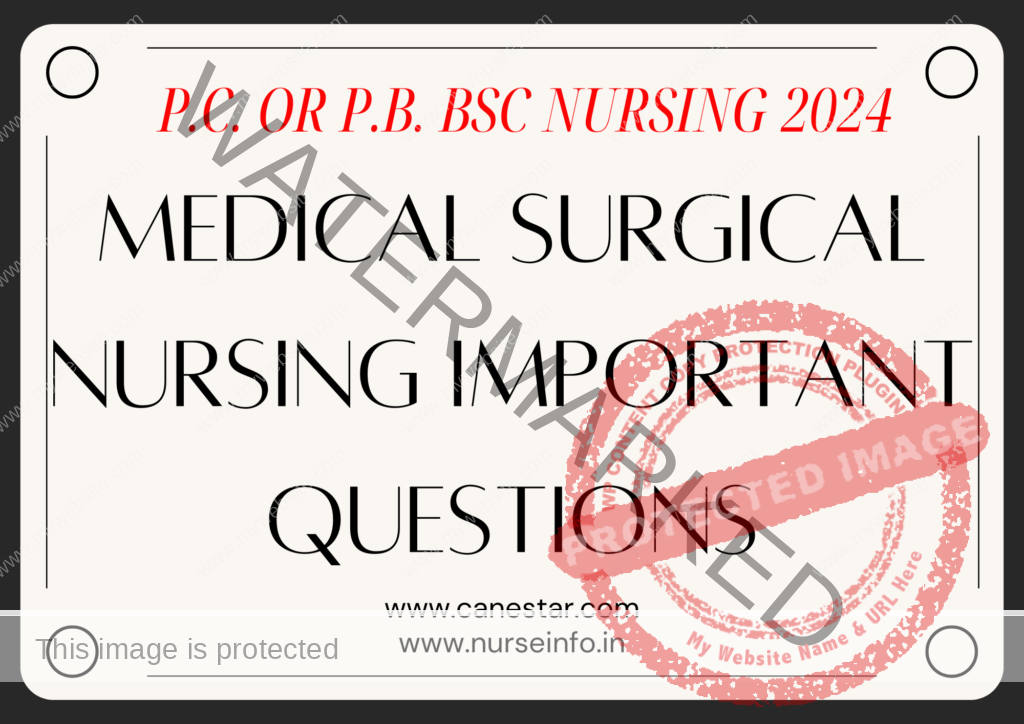Medical Surgical Nursing
Important Questions
FOR P.C. OR P.B. BSC NURSING 2024
Medical Surgical Nursing Important Questions, P.C. or P.B. BSC First Year Nursing based on INC AND RGUHS
LONG ESSAYS
- Explain the clinical features of diabetes mellitus. Enlist the nursing diagnosis and nursing interventions
- Management of fractures
- Cirrhosis of liver and its complications
- Define and classify cerebro vascular accident. Describe the pathophysiological changes with clinical manifestation.
- Define burns and state its classification. Discuss pathophysiology with clinical manifestations
- Discuss the causes and risk factors of COPD, with pathophysiological changes. Management of COPD
- Define shock and explain the stages of shock with clinical manifestations
- Pathophysiology and clinical manifestations of myocardial infarction.
- Define cerebro vascular accident. List the causes of ischemic stroke and hemorrhagic stroke
- Define bronchial asthma. Nursing management
- Describe the classification, clinical manifestation and management of diabetes mellitus
- Define epilepsy. List and explain the classification of seizures. Discuss the nurse’s responsibilities
- Define asthma. Explain pathophysiology and nursing management
- Define glaucoma. List the types of glaucoma. List the surgical approaches and management
- Define and classify shock. Explain management of patient in hypovalemic shock
- Define fracture. List different types of fractures. Nursing care
- Define hemiplegia. Management of hemiplegia
- Intestinal obstruction and management
- Burns and management
- Hypertension
- Pneumonia
- Acute renal failure
- Define peptic ulcer. Difference between peptic and duodenal ulcer.
SHORT ESSAYS
- Nephrotic syndrome
- Myxoedema
- Cardiogenic shock
- Rehabilitation in COPD
- Principle of an Intensive Care Unit
- Complications of burns
- Care of an unconscious patient
- Care of a patient undergoing radiotherapy
- Continuous ambulatory peritoneal dialysis
- Shock and its management
- Poisoning and its first aid management
- Pleural effusion
- Fluid and electrolyte imbalances
- Diabetes mellitus
- Ischemic heart disease
- Surgical approaches of peptic ulcer
- AIDS
- Explain the pathophysiology of diabetes mellitus
- What are the different stages of epileptic attack
- Management of pulmonary tuberculosis
- Mode of transmission of hepatitis B virus and prevention
- What is lithotripsy. What are the different techniques of lithotripsy
- Define anemia. Management of iron deficiency anemia
- Define peptic ulcer disease and difference between gastric ulcer and duodenal ulcer
- Cardiaogenic shock
- Psoriasis
- Osteoarthritis
- Respiratory arrest
- Management of pain
- Infective hepatitis
- Raynaud’s disease
- Corpulmonale
- Nephritic syndrome
- Nurse’s responsibilities before, during and after blood transfusion
- Pathophysiology of congestive cardiac failure
- Health education for a patient hepatitis
- Complications of diabetes mellitus
- Stages of bone healing
- Haemodialysis
- Tracheostomy care
- Surgical measures for cataract
- Diagnostic measures in pulmonary tuberculosis
- Care of unconscious patient
- Treadmill test
- Complications of hypertension
- Benign prostatic hyperplasia
- Diabetes insipedis
- Bone healing
- Cirrhosis of liver
- Mammography
- Water seal chest drainage
- Nursing management of patient with shock
- Leukemia
- Tracheostomy
- Cataract
- Percutaneous transluminal coronary angioplasty
- Colostomy
- Management of diabetes mellitus
- Risk factors of coronary artery disease
- Acidosis
- Arrhythmias
- COPD
- Radiotherapy
- Malaria
- Thyroid crisis
- Leukemia
- Tonsillitis
- Nurse responsibilities in blood transfusion
- Nurses role in cancer chemotherapy
- Postural drainage
- Acute renal failure
- Pancreatitis
- Management of snake bite
- Care of patient on intercostals drainage
- Nursing management of pain
- Thyroid crisis
- Equipments in an ICU
- Sub acute bacterial endocarditis
- Haemodialysis
- Diabetic diet
- Cushings syndrome
- Herpes zoster
- Cardiac arrest
- Peptic ulcer
- End stage renal disease
- Colitis
- Pleural effusion
- Hypophysectomy
- Prolapsed disc
- Amputation
- Scabies
- Cardio pulmonary resuscitation
- Lung abscess
- Broncho dilators
- Surgical management of renal calculi
- Puva therapy
- Dialysis
- Bronchiectasis and its management
- Brain tumor
SHORT ANSWERS
- Pneumothorax
- Digitalis toxicity
- Cardiac tamponade
- Standard precautions
- Epistaxis
- Types of arrhythmias
- Osteroporosis
- Management of renal calculi
- Complications of tonsillectomy
- Tetany
- Cardiac monitors
- Benign prostatic hypertrophy
- Pneumonia
- Hypertensive crisis
- Types of anaesthesia
- Hemorrhoids
- Urinary incontinence
- Traction
- Pacemaker
- Inflammation
- Differentiate between cardio version and defibrillation
- What is thalassemia
- What is dumping syndrome.
- List the types of cataract
- What is otosclerosis
- What is acute adrenal insufficiency
- Differentiate between azotemia and uremia
- List the diagnostic measures in osteoporosis
- What is pap smear
- List the clinical manifestations in endocarditis
- Diuretics
- Dyspnoea
- Hiatus hernia
- Dengue fever
- Goiter
- Infertility
- Epispadiasis
- Pericarditis
- Hemorrhoids
- Endoscopy
- Amputation
- Types of shock
- Causes of blindness
- Types of aphasia
- Quinsy
- Paraplegia
- Chorea
- Cholecystitis
- Haemophilia
- Emphysema
- Scalds
- Prosthetic valves
- Purpura
- Phenyntoin
- Incontinence
- Defibrillation
- Cardiac marker s
- Pulse oxymetry
- Anal fistula
- Euthyroid
- Haemophilia
- Tonometry
- Diarrhea
- Endoscopy
- Electro encephalo gram
- Hepatitis
- Anal fissure
- Arthritis
- Antacids
- Electro cardiogram (ECG)
- Pemphigus
- Subluxation
- Fistula
- Emphysema
- Ophthalmic drugs
- Aneurysm
- Pyurea
- Fever
- Incontinence
- Emphysema
- Anal fissure
- Angina
- Glaucoma
- Atelectasis
- Phantom limb
- Cause of cardiac arrest
- Breath sounds
- Types of CVA
- Complications of blood transfusion
- Antiepileptic drugs
- Types of fractures
- Status Asthamaticus
- Types of Traction
- Pheochromacytoma
- Intractable pain
- Fissure in ANO
- Prosthesis
- Anasarca
- Seizure
- Tetany
- Hemorrhoids
- Myopia
- Iron deficiency anemia
- Percentage of burns
- Goiter
- Bursitis
- Prevention of urinary tract infection
- Pap smear
- Purpura
- Streptokinase
- Chicken pox
- Portal hypertension
- Vesico vaginal fistula
- Reconstructive surgery
- Mannitol

